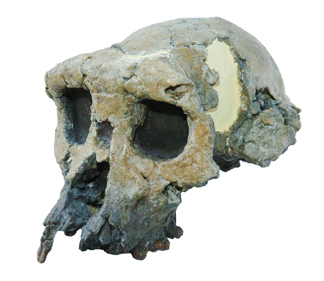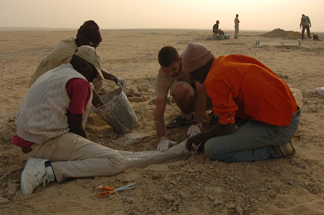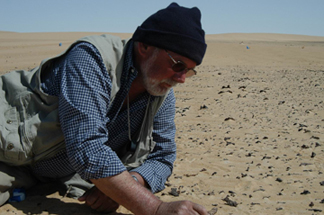Geotimes

Untitled Document

Web Extra
Friday, Apr. 15, 2005
New
evidence for the earliest hominid
In 2002, a team of researchers found a skull in the deserts of Central Africa.
Dubbed "Toumaï," which means "hope of life" in the
local language of Chad, the skull was assigned to a new group of hominid, Sahelanthropus
tchadensis (see Geotimes, Sept 2002). However, the skull produced
controversy over whether it was truly a hominid, and not a species of ape or
chimpanzee. Now scientists say they have new evidence confirming that Toumaï
is a new hominid species — the oldest known to date.
The team, an international and interdisciplinary group known as the Mission
Paleoanthropologique Franco-Tchadienne (MPFT), discovered new fossils of jawbones
and teeth belonging to S. tchadensis from the same site that produced
the skull in Chad. These finds, along with a virtual reconstruction of the Toumaï
skull — two separate studies published in the April 7 Nature —
help establish what scientists originally thought: Toumaï is a separate
species more closely related to humans than to the apes and chimps.
 "The
new material essentially confirms the original diagnosis of the species,"
says Daniel Lieberman, a professor of biological anthropology at Harvard University
and co-author on both papers. "The skull has a huge number of features
that resemble hominids, not apes — not only in early hominids, but also
in later hominids."
"The
new material essentially confirms the original diagnosis of the species,"
says Daniel Lieberman, a professor of biological anthropology at Harvard University
and co-author on both papers. "The skull has a huge number of features
that resemble hominids, not apes — not only in early hominids, but also
in later hominids."
This skull, identified as S. tchadensis
and found in Chad, is the oldest evidence of hominid evolution, according to
new research. Image courtesy of MPFT.
The skull is unique because of its age and geographic location, says Michel
Brunet from the University of Poitiers in France, an author on both studies
and head of MPFT. The bones were located more than 2,000 miles from the Rift
Valley where most ancestral human fossils have been found. The location, Brunet
says, indicates that the dispersal of the earliest hominids is not localized
in a particular region, such as Eastern Africa, as typically thought.
Toumaï is approximately 7 million years old, 4 million years older than
the famed "Lucy," Brunet says. "This is older than the molecular
biologists think of the last split" in the lineage between humans and apes,
he says. Previously thought to be about 5 million years ago, humans and apes
split from a common ancestor that would have been related to both groups. Based
on Toumaï, "now we know that the split between humans and apes is
between 7 and 8 million years ago."
 Scientists
reconstructed the skull by scanning it and affixing data points to particular
regions to create a virtual replica. "This was a real technological tour
de force," says John Fleagle, an anatomist at State University of New York,
Stony Brook, who was not affiliated with the research. "You can put bones
together and take them apart and you don't have to actually touch the fossil."
Scientists
reconstructed the skull by scanning it and affixing data points to particular
regions to create a virtual replica. "This was a real technological tour
de force," says John Fleagle, an anatomist at State University of New York,
Stony Brook, who was not affiliated with the research. "You can put bones
together and take them apart and you don't have to actually touch the fossil."
The Mission Paleoanthropologique Franco-Tchadienne
(MPFT), an international, interdisciplinary team of scientists is searching
for fossil remains of ancestral humans in Central Africa. Image courtesy of
MPFT.
The virtual skull was manipulated to resemble the facial features of nonhominid
primates to test the possibility that it may be related to some other group,
but "it just didn't reconstruct that way," Fleagle says. When trying
to make a chimp face out of the Toumaï skull data points, areas of the
bones start to overlap and produce gaps in other places. In the case of trying
to make a gorilla out of the Toumaï bones, the two sides of the braincase
overlap because of a gorilla's smaller brain size, Fleagle says; it is also
impossible to elongate the face of the Toumaï skull to replicate a gorilla's
snout.
Other factors about the skull also indicate that it was more hominid-like than
ape-like, Fleagle says. For instance, the jawbones lack a sharpening mechanism
notable on apes that have long, pointed canines. Also, the digital reconstruction
of the skull shows Toumaï to have a short, flat face, like that of more
modern humans, Lieberman says, and unlike Lucy (an Australopithecus afarensis),
who had a much longer face.
 The
reconstruction team also says that Toumaï was a biped, walking upright
on two legs, based on the position of the opening in the neck for the spinal
cord. In most primates, the neck is bent backwards to hold the head upright
while walking on all fours. "It's a bit of a stretch," Fleagle says,
as they have only found the creature's skull. "You'd like to have legs
before you start talking about how it moved."
The
reconstruction team also says that Toumaï was a biped, walking upright
on two legs, based on the position of the opening in the neck for the spinal
cord. In most primates, the neck is bent backwards to hold the head upright
while walking on all fours. "It's a bit of a stretch," Fleagle says,
as they have only found the creature's skull. "You'd like to have legs
before you start talking about how it moved."
Michel Brunet of the University of Poitiers
and head of MPFT, searches the sands of the African desert in search of more
evidence of Toumaï. Image courtesy of MPFT.
The next step is to find more comparable specimens from the late Miocene, says
Brunet, who has already started looking. He would also like the team to start
digging into deposits older than those in which Toumaï was found. "What
happened in the older level should reveal something more about human evolution,"
Brunet says, "because Toumaï is not far from the common ancestor."
Until more specimens are found, however, scientists will continue to analyze
Toumaï, providing more detailed descriptions of the morphological and anatomical
features, Fleagle says. "It's a puzzle where this guy fits in," Lieberman
says. "It's difficult to figure out evolutionary relationships from the
lumps and bumps on bones."
Laura Stafford
Links:
MPFT
homepage
"Fossil find reveals
evolutionaty montage" Geotimes, September 2002
Back to top
Untitled Document

 "The
new material essentially confirms the original diagnosis of the species,"
says Daniel Lieberman, a professor of biological anthropology at Harvard University
and co-author on both papers. "The skull has a huge number of features
that resemble hominids, not apes — not only in early hominids, but also
in later hominids."
"The
new material essentially confirms the original diagnosis of the species,"
says Daniel Lieberman, a professor of biological anthropology at Harvard University
and co-author on both papers. "The skull has a huge number of features
that resemble hominids, not apes — not only in early hominids, but also
in later hominids."
 Scientists
reconstructed the skull by scanning it and affixing data points to particular
regions to create a virtual replica. "This was a real technological tour
de force," says John Fleagle, an anatomist at State University of New York,
Stony Brook, who was not affiliated with the research. "You can put bones
together and take them apart and you don't have to actually touch the fossil."
Scientists
reconstructed the skull by scanning it and affixing data points to particular
regions to create a virtual replica. "This was a real technological tour
de force," says John Fleagle, an anatomist at State University of New York,
Stony Brook, who was not affiliated with the research. "You can put bones
together and take them apart and you don't have to actually touch the fossil." The
reconstruction team also says that Toumaï was a biped, walking upright
on two legs, based on the position of the opening in the neck for the spinal
cord. In most primates, the neck is bent backwards to hold the head upright
while walking on all fours. "It's a bit of a stretch," Fleagle says,
as they have only found the creature's skull. "You'd like to have legs
before you start talking about how it moved."
The
reconstruction team also says that Toumaï was a biped, walking upright
on two legs, based on the position of the opening in the neck for the spinal
cord. In most primates, the neck is bent backwards to hold the head upright
while walking on all fours. "It's a bit of a stretch," Fleagle says,
as they have only found the creature's skull. "You'd like to have legs
before you start talking about how it moved." 